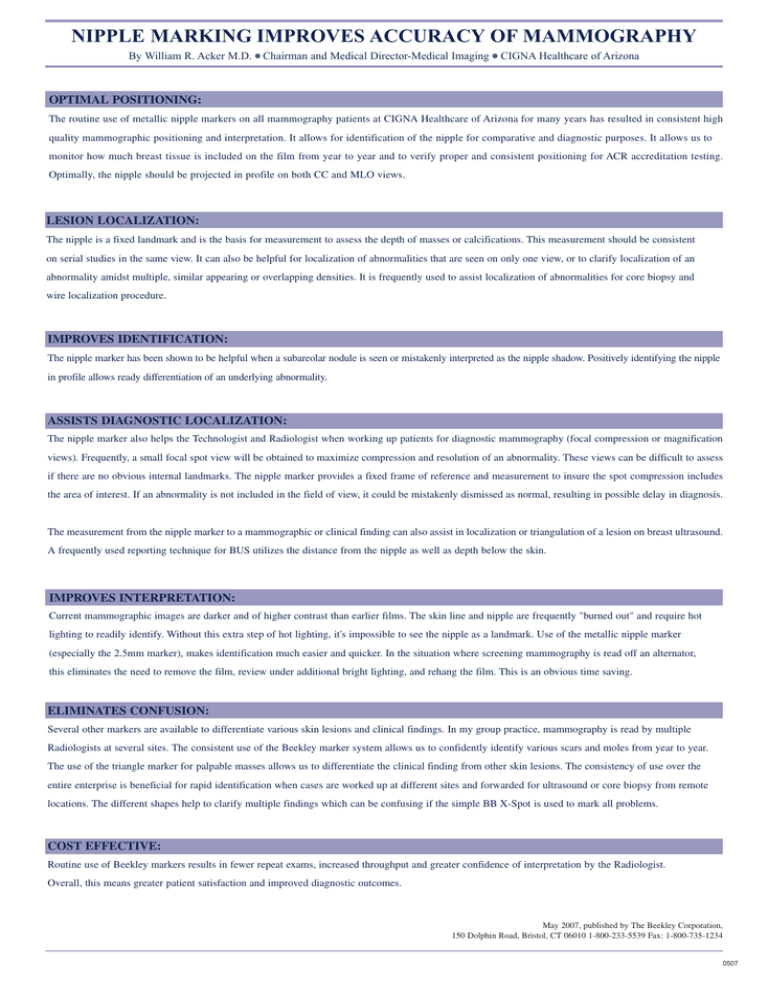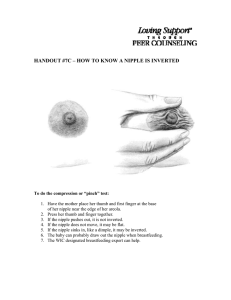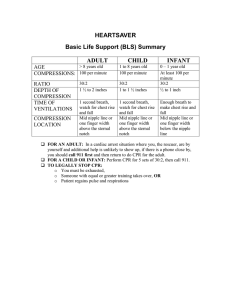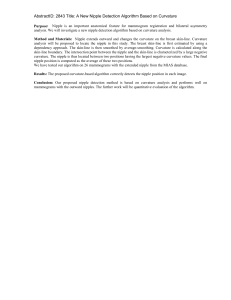nipple marking improves accuracy of
advertisement

NIPPLE MARKING IMPROVES ACCURACY OF MAMMOGRAPHY By William R. Acker M.D. ● Chairman and Medical Director-Medical Imaging ● CIGNA Healthcare of Arizona OPTIMAL POSITIONING: The routine use of metallic nipple markers on all mammography patients at CIGNA Healthcare of Arizona for many years has resulted in consistent high quality mammographic positioning and interpretation. It allows for identification of the nipple for comparative and diagnostic purposes. It allows us to monitor how much breast tissue is included on the film from year to year and to verify proper and consistent positioning for ACR accreditation testing. Optimally, the nipple should be projected in profile on both CC and MLO views. LESION LOCALIZATION: The nipple is a fixed landmark and is the basis for measurement to assess the depth of masses or calcifications. This measurement should be consistent on serial studies in the same view. It can also be helpful for localization of abnormalities that are seen on only one view, or to clarify localization of an abnormality amidst multiple, similar appearing or overlapping densities. It is frequently used to assist localization of abnormalities for core biopsy and wire localization procedure. IMPROVES IDENTIFICATION: The nipple marker has been shown to be helpful when a subareolar nodule is seen or mistakenly interpreted as the nipple shadow. Positively identifying the nipple in profile allows ready differentiation of an underlying abnormality. ASSISTS DIAGNOSTIC LOCALIZATION: The nipple marker also helps the Technologist and Radiologist when working up patients for diagnostic mammography (focal compression or magnification views). Frequently, a small focal spot view will be obtained to maximize compression and resolution of an abnormality. These views can be difficult to assess if there are no obvious internal landmarks. The nipple marker provides a fixed frame of reference and measurement to insure the spot compression includes the area of interest. If an abnormality is not included in the field of view, it could be mistakenly dismissed as normal, resulting in possible delay in diagnosis. The measurement from the nipple marker to a mammographic or clinical finding can also assist in localization or triangulation of a lesion on breast ultrasound. A frequently used reporting technique for BUS utilizes the distance from the nipple as well as depth below the skin. IMPROVES INTERPRETATION: Current mammographic images are darker and of higher contrast than earlier films. The skin line and nipple are frequently "burned out" and require hot lighting to readily identify. Without this extra step of hot lighting, it's impossible to see the nipple as a landmark. Use of the metallic nipple marker (especially the 2.5mm marker), makes identification much easier and quicker. In the situation where screening mammography is read off an alternator, this eliminates the need to remove the film, review under additional bright lighting, and rehang the film. This is an obvious time saving. ELIMINATES CONFUSION: Several other markers are available to differentiate various skin lesions and clinical findings. In my group practice, mammography is read by multiple Radiologists at several sites. The consistent use of the Beekley marker system allows us to confidently identify various scars and moles from year to year. The use of the triangle marker for palpable masses allows us to differentiate the clinical finding from other skin lesions. The consistency of use over the entire enterprise is beneficial for rapid identification when cases are worked up at different sites and forwarded for ultrasound or core biopsy from remote locations. The different shapes help to clarify multiple findings which can be confusing if the simple BB X-Spot is used to mark all problems. COST EFFECTIVE: Routine use of Beekley markers results in fewer repeat exams, increased throughput and greater confidence of interpretation by the Radiologist. Overall, this means greater patient satisfaction and improved diagnostic outcomes. May 2007, published by The Beekley Corporation, 150 Dolphin Road, Bristol, CT 06010 1-800-233-5539 Fax: 1-800-735-1234 0507


